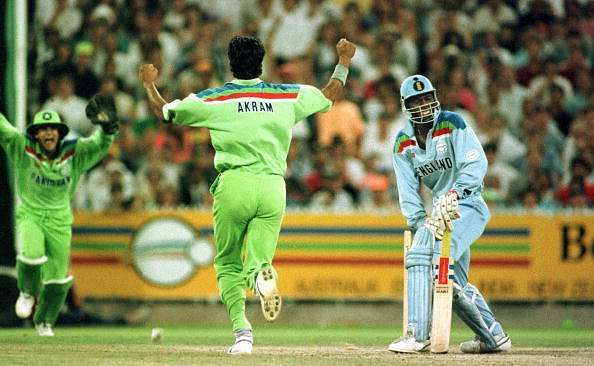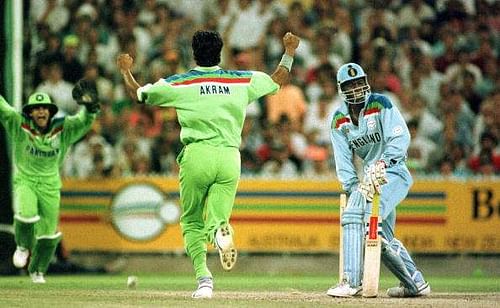
Fast bowling from around the wicket: A dying art?
World Cricket has seen a transformation in recent times with the kind of pitches rolled out for Test and ODI games. With the popularity of the shortest format, T20, gaining rapid popularity, the focus has shifted largely to run-scoring pitches, where batsmen flourish as that is what viewers are expected to like to see.
Allegations from bowlers that the game is largely biased towards batsmen are not totally baseless, considering these flat pitches. Mediocre batsmen, with flawed techniques, have managed to score runs on these flat tracks.
But haven't viewers enjoyed the great West Indian fast bowlers of yesteryear's giving the batsmen a working over? Or the Australian trio of Brett Lee-Glenn Mcgrath-Jason Gillespie out-thinking the batsmen with skill? Or those toe-crushing pacy yorkers from Wasim Alarm, Shoaib Akhtar and Waqar Younis?
The fact is viewers are believed to like just bash-and-crash T20s. They would easily love to see an equal battle between bat and ball and would even love if bowlers get an upper hand, like that famous Wahab Riaz over to Shane Watson in the 2015 ODI World Cup.
But with pitches becoming more and more flat or subcontinent-ish in recent years, bowlers, especially pace bowlers, are able to extract little from the surface. But have they tried enough? Is it that they do not have enough skills or that they do not explore enough options?
On flat tracks, even in Test matches, there is no point in bowling the fifth stump line to batsmen, as Test match handbooks prescribe. Bowling at the wicket is the answer. But against skilled, modern batsmen wielding willows the size of tree trunks, one-dimensional bowling is never going to work.
So where have fast bowlers lost those variations? They may miss an ample lot of varieties in bowling. But what about the approach to the wicket, especially the angle from around the wicket? A change in angle is as good a variation as any.
Not convinced? Ever seen Wasim Akram bowl in the 1992 World Cup final? Chasing 250 for victory, England were cruising thanks to the Fairbrother-Lamb partnership, after being in a spot of bother at 69/4. The partnership was worth 72 when Wasim Akram bowling around the wicket, produced a dream delivery. The ball pitched just outside off stump, went with the angle, prompting a defensive push from Lamb, but the ball eluded the bat as it swung away late and clipped the off stump bails. The celebrations were wild.
It was a big breakthrough and Wasim Akram had produced it yet again. He wasn't done, though.
Chris Lewis, who watched this from the pavilion was soon in the middle. Akram had another special delivery up his sleeve. The next ball pitched almost at the same spot as the previous, and went with the angle, but swung in sharply, instead of away. Lewis was totally cramped for room and lost his stumps. England were 141/6 all of a sudden with 250 looking a continent away.
It wasn't the first time in the 1992 World Cup that Akram had used the angle to baffle the batsmen. He had used it effectively at the death against South Africa earlier. But that time he relied on yorkers that swung late since it was the death overs. This time, it was the sheer skill of making the ball talk from a different angle that did Lamb and Lewis.
Akram wasn't the first to totally nail bowling from around the wicket. Malcolm Marshall was lethal from around the wicket and used his pace and bounce to trouble right-handers. Apart from cramping him for room, the batsmen had to change his line of sight, which caused more problems when the bowler was someone with the height of Marshall. The body line kind of bowling always accompanied a short leg or short fine leg waiting for that gloved edge. It was different thinking. It was a different skill.
Clock back a bit to the 1996 World Cup. Venkatesh Prasad was slammed to the boundary by Aamer Sohail in that India-Pakistan encounter. Prasad was already bowling around the stumps. The trick with the angle is, you can barely distinguish, as a batsman, if the ball is going to seam away or come with the angle. Prasad's follow up delivery went on with the angle and shattered Sohail's stumps.
Look at Flintoff in the famous 2005 Ashes series. Australia's left-handers Matthew Hayden, Justin Langer, Adam Gilchrist and Simon Katich were largely silenced by Flintoff's around the wicket tactic, cramping them for room. Gilchrist, in particular, failed to get his aggressive approach going, as he could not get the leeway to free his arms. Gilchrist termed the 2005 Ashes series as the 'worst time' of his cricketing life.
Gilchrist, later commented, "On his home turf, Freddie Flintoff looked 10 feet tall. We weren't beaten on the field. Ricky played a majestic match- saving 156, before Binga and Pigeon kept out the last few balls. I failed again. I'd dearly wanted to rally around Punter [Ponting], and my strategy was to take my time and slow right down, to give myself a chance. I batted 30 balls for 4. I'd done a total about-face on my natural game, and the opposition knew it. In the end, Flintoff came around the wicket and I edged one to gully. It was only a matter of time."
"For the next Test, in Nottingham, my confidence was at an all-time low. They passed 400 in the first innings for the third straight time. We hadn't attained 400 once. I went in at 5-99 and for the first time in weeks felt comfortable. If I could just get through Flintoff's spell, everything else would settle down. Most importantly, I'd be able to dispel the theory that I couldn't cope with Flintoff around the wicket. I needed to convince myself of that. But then he came around the wicket again, I slashed at one, and [Andrew] Strauss, at full stretch diving to his left at second slip, took an absolute screamer. I was truly born under a bad sign for that tour.", Gilchrist mourned.
It was evident that Flintoff's ploy of going around the stumps had paid rich dividends.
Zaheer Khan and RP Singh also used the around the wicket tactic to perfection in England in 2007. The left-arm pace bowling duo found late reverse swing and exploited it fully to lead India's bowling attack that tour. Memories of RP Singh cleaning up Michael Vaughan at Lord's with a screamer from around the stumps come to mind.
Who can forget Mitchell Johnson's fiery bowling in the 2013 Ashes against England? His frequent short stuff to left-handers, Carberry and Broad in particular, completely disoriented the English. With a short leg and short fine leg in place at most times, Johnson mixed the short stuff with the occasional full ball from around the stumps. The angle, a considerable shift in the line of sight, caused huge problems for the lefties. More often than not, Johnson's pace combined with the angle, led to a wicket.
Johnson's short bowling in that series was reminiscent of the great Malcolm Marshall.
Morne Morkel, possibly taking a leaf out of Johnson's bowling in the Ashes, resorted to around the wicket bowling in the Tests against Australia the following year. His battle with Michael Clarke, where he troubled the Aussie captain with his line and length from around the stumps, stood out. Clarke was hit multiple times on the helmet and arms and nearly edged to short leg 3-4 times. Though he survived Morkel's burst, it was evident that the angle troubled him and a more accurate field would have seen him walk back pretty quickly. It wasn't the only time Morkel used the tactic, though. He often came around the wicket to left-handers early in his career and has had good success. With his height, he extracted good bounce from any surface and troubled lefties.
It is not that the modern bowlers lack this particular skill. We have seen Broad and particularly Mitchell Starc of late, use the angle to trouble batsmen. But have they been using it often enough? When England drubbed Australia in the return Ashes in 2015, Starc and Johnson rarely used the ploy while Broad wrecked havoc at Trent Bridge with the very same tactic. Broad had four of his eight wickets, all left-handers, all caught at the slip cordon, from around the stumps. Australia were bundled out for 60 in the first innings.
Broad, however, was rarely seen using the tactic to make batsmen play at the ball, since then. He barely used it against Pakistan in the recently concluded series between the two.
Starc was seen using the tactic in the recently concluded Australian tour of Lanka. In the Tests, his reverse swing from around the wicket helped him big time. Starc had 24 wickets in the series at an average of 15.16. That the other pacers just took 13 wickets in the whole series shows how good he was. And he used the angle quite a lot against the right-handers. In sub-continental wickets, where you want the batsman to play at most balls, around the stumps bowling is something any fast bowler would be required to have in his arsenal.
With modern batsmen taking wild detours to score runs, it is not long before bowlers become mere spectators unless they come up with tactics of their own. Just like Starc and Broad have shown in recent times, it need not be big variations. A minor change in the angle when approaching the stumps, can do wonders. It is just that very few bowlers in the modern game use this easy alternative.
Unlike the common misconception, viewers totally love a battle where the bowlers dominate. Some great fast bowlers like Kagiso Rabada and Alzarri Joseph are being unearthed from various parts of the globe. While they concentrate on the basics, it would stand them in good stead if they increase the number of tricks they possess in their repertoire. The art of bowling around the stumps is a simple, but effective way to get the batsman out of his comfort zone. Let us look forward to more intriguing battles between batsmen and bowlers, where it takes every ounce of the batsman's skill to outclass a bowler.
